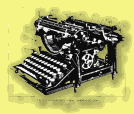
 |
|
|
|
How to Repair Underwood TypewritersQuick reference to locating troubleI'm scanning and putting in hypertext format an old Service Technical Manual "How to Repair Underwood Typewriters". As new pages will be finished they will be added here.Note: The following notes and questions are merely an aid in locating where trouble can be found with the most common troubles found in Underwood Typewriter Repairing. To adjust correctly, follow the foregoing instructions listed in contents under title of Part Affected. |
Problems you can fix using this guide:
|
|
To open plates in a new window, so you can look at text and images at the same time, click for Plate 2 3 4 5 6 7 8 9 10
|
Irregular Spacing Between Lines.
|
|||
|
Caused by line space lever throwing too far and ratchet pawl landing on top of ratchet tooth, jumping back when machine is in operation. |
|||
|
||||
|
Carriage Failing to
Space Properly.
|
|
|||
|
|
|||
|
|
|||
|
Adjust as per instructions. The throw of ribbon guide is too high or too low.
|
||||
|
Ribbon Does Not Reverse
Automatically. The following references all refer to Plate 4.
|
(to be continued...) |